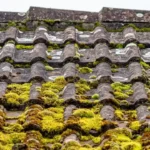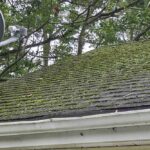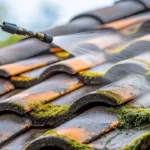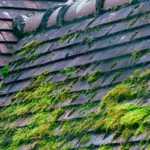The roof moss vinegar method is becoming an increasingly popular choice among homeowners for maintaining their roofs. This natural approach not only helps in removing moss effectively but also reduces the reliance on chemical treatments. By understanding how this method works, homeowners can save on maintenance costs and extend the life of their roofs.

Understanding Roof Moss
Moss is a common occurrence on roofs, especially in areas with high humidity and shade. It can appear as a green, velvety layer on shingles, which might seem harmless at first. However, if left untreated, moss can cause significant damage, leading to leaks and structural issues. For more information on how moss affects roofs, you can visit does moss mean roof replacement?
Why Moss Grows on Roofs
Moss thrives in damp environments, making roofs with poor drainage or excessive shade ideal breeding grounds. Overhanging trees, gutters clogged with debris, and north-facing roofs that receive less sunlight can exacerbate moss growth. Regular maintenance and awareness of these factors can prevent moss from becoming a serious issue.
The Benefits of Using Vinegar
Vinegar is a natural, non-toxic substance that is effective in killing moss without harming the environment. Here are some benefits of using vinegar:
- Eco-Friendly: Unlike chemical treatments, vinegar is biodegradable and does not pose a threat to wildlife or plants.
- Cost-Effective: Vinegar is affordable and readily available, making it a budget-friendly option for homeowners.
- Safe for Pets: For those concerned about the safety of their pets, vinegar is a safe alternative to chemical moss removers. Learn more about roof moss and pet safety.
How to Apply the Vinegar Method
Applying the roof moss vinegar method is a straightforward process. Here’s a step-by-step guide:
Materials Needed
- White vinegar
- Spray bottle
- Soft brush or broom
- Protective gear (gloves and goggles)
Step-by-Step Procedure
- Prepare the Solution: Fill a spray bottle with pure white vinegar. For larger areas, a pump sprayer may be more efficient.
- Apply to Moss: Spray the vinegar directly onto the mossy areas of the roof. Ensure the moss is thoroughly saturated.
- Let it Sit: Allow the vinegar to sit for 24 to 48 hours. This will give it ample time to penetrate and kill the moss.
- Remove Dead Moss: After the waiting period, use a soft brush or broom to gently remove the dead moss. Avoid using high-pressure washers, as they can damage shingles.
- Rinse the Roof: Lightly rinse the area with water to wash away any remaining vinegar and debris.
Preventing Moss Regrowth
After successfully removing moss, it’s important to prevent its return. Regular maintenance can help keep your roof moss-free.
Maintenance Tips
- Trim overhanging branches to reduce shade and improve sunlight exposure.
- Clean gutters regularly to ensure proper drainage.
- Inspect the roof annually for signs of moss and address issues promptly.
- For more maintenance tips, check out maintaining roofs post moss removal.
Comparing Vinegar to Other Methods
While vinegar is effective, it’s worth comparing it to other methods to understand its advantages.
Chemical Treatments
Chemical treatments are often faster and more potent but come with environmental risks and potential damage to the roof. They also require professional application, which can increase costs.
Pressure Washing
Pressure washing can quickly remove moss but may damage shingles if not done carefully. It also does not prevent regrowth.
Physical Removal
Using a brush or broom to manually remove moss is effective but labor-intensive and may not remove all spores, allowing regrowth.
Conclusion
The roof moss vinegar method offers an effective, eco-friendly solution for homeowners looking to maintain their roofs without resorting to harsh chemicals. By understanding the causes of moss growth and taking preventive measures, homeowners can enjoy a moss-free roof for years to come. For more insights on roof maintenance, consider reading about the differences between moss and algae stains.

FAQs
Can vinegar damage my roof?
No, vinegar is a mild acid and is generally safe for most roofing materials when used properly. However, it’s important to rinse the roof after treatment to remove any residue.
How often should I use the vinegar method?
It’s recommended to apply the vinegar method annually or whenever you notice moss beginning to appear. Regular maintenance can help prevent significant moss growth.
Is the vinegar method effective on all types of moss?
Yes, vinegar is effective against most types of moss commonly found on roofs. However, for extensive infestations, it might be necessary to combine treatments.
This article contains affiliate links. We may earn a commission at no extra cost to you.








